Radio-frequency identification (RFID) uses electromagnetic fields to automatically identify and track tags attached to objects. An RFID system consists of a tiny radio transponder, a radio receiver and transmitter. When triggered by an electromagnetic interrogation pulse from a nearby RFID reader device, the tag transmits digital data, usually an identifying inventory number, back to the reader. This number can be used to track inventory goods.

A subdermal implant is a body modification placed under the skin, allowing the body to heal over the implant and creating a raised design. Such implants fall under the broad category of body modification. Many subdermal implants are made out of silicone, either carved or mold injected. Many people who have subdermal implants use them in conjunction with other types of body modification to create a desired, dramatic effect. This process is also known as a 3-D implant, or pocketing.

Livestock branding is a technique for marking livestock so as to identify the owner. Originally, livestock branding only referred to hot branding large stock with a branding iron, though the term now includes alternative techniques. Other forms of livestock identification include freeze branding, inner lip or ear tattoos, earmarking, ear tagging, and radio-frequency identification (RFID), which is tagging with a microchip implant. The semi-permanent paint markings used to identify sheep are called a paint or color brand. In the American West, branding evolved into a complex marking system still in use today.

A microchip implant is an identifying integrated circuit placed under the skin of an animal. The chip, about the size of a large grain of rice, uses passive radio-frequency identification (RFID) technology, and is also known as a PIT tag. Standard pet microchips are typically 11–13 mm long and 2 mm in diameter.
ISO 11784 and ISO 11785 are international standards that regulate the radio-frequency identification (RFID) of animals, which is usually accomplished by implanting, introducing or attaching a transponder containing a microchip to an animal.

An ear tag is a plastic or metal object used for identification of domestic livestock and other animals. If the ear tag uses Radio Frequency Identification Device (RFID) technology it is referred to as an electronic ear tag. Electronic ear tags conform to international standards ISO 11784 and ISO 11785 working at 134.2 kHz, as well as ISO/IEC 18000-6C operating in the UHF spectrum. There are other non-standard systems such as Destron working at 125 kHz. Although there are many shapes of ear tags, the main types in current use are as follows:
The National Animal Identification System, (naisG) is a government-run program in the United States intended to extend government animal health surveillance by identifying and tracking specific animals. Administered at the federal level by the Animal and Plant Health Inspection Service, a branch of the United States Department of Agriculture, NAIS will also be overseen by state animal health boards. While the federal program is voluntary, money received by some states, tribes, and non-profit entities from the USDA through cooperative agreements has been used to make parts or all of the program mandatory.
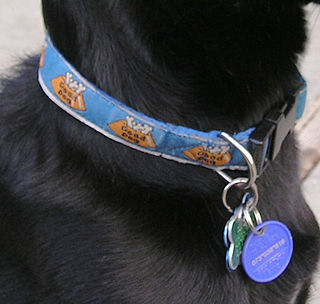
A dog tag, cat tag, pet ID tag, or pet tag is a small flat tag worn on pets' collars or harnesses.

Animal migration tracking is used in wildlife biology, conservation biology, ecology, and wildlife management to study animals' behavior in the wild. One of the first techniques was bird banding, placing passive ID tags on birds legs, to identify the bird in a future catch-and-release. Radio tracking involves attaching a small radio transmitter to the animal and following the signal with a RDF receiver. Sophisticated modern techniques use satellites to track tagged animals, and GPS tags which keep a log of the animal's location. With the Emergence of IoT the ability to make devices specific to the species or what is to be tracked is possible. One of the many goals of animal migration research has been to determine where the animals are going; however, researchers also want to know why they are going "there". Researchers not only look at the animals' migration but also what is between the migration endpoints to determine if a species is moving to new locations based on food density, a change in water temperature, or other stimulus, and the animal's ability to adapt to these changes. Migration tracking is a vital tool in efforts to control the impact of human civilization on populations of wild animals, and prevent or mitigate the ongoing extinction of endangered species.
Acoustic tags are small sound-emitting devices that allow the detection and/or remote tracking of organisms in aquatic ecosystems. Acoustic tags are commonly used to monitor the behavior of fish. Studies can be conducted in lakes, rivers, tributaries, estuaries or at sea. Acoustic tag technology allows researchers to obtain locational data of tagged fish: depending on tag and receiver array configurations, researchers can receive simple presence/absence data, 2D positional data, or even 3D fish tracks in real-time with sub-meter resolutions.
The Southwestern Native Aquatic Resources and Recovery Center, formerly known as Dexter National Fish Hatchery & Technology Center, is a U.S. Fish and Wildlife Service facility dedicated to fish culture techniques for threatened and endangered fishes of the American Southwest. Located in Dexter, New Mexico, it is the only federal facility in the nation dedicated to studying and holding only threatened and endangered fish. Scientists at the Dexter facility perform life history studies and carefully analyze fish genetics while maintaining a refuge for 16 imperiled fish species. Dexter National Fish Hatchery was established in 1931, to satisfy demands for game fish throughout the Southwest. New laws brought changes to the hatchery in the 1970s.
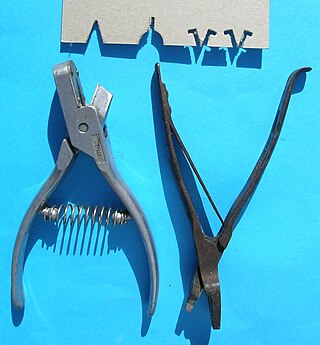
An earmark is a cut or mark in the ear of livestock animals such as cattle, deer, pigs, goats, camels or sheep, made to show ownership, year of birth or sex.
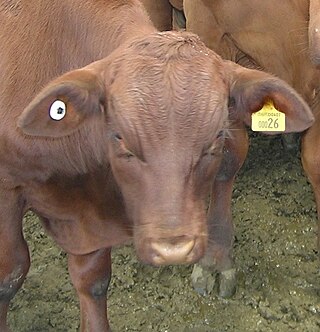
The National Livestock Identification System (NLIS) is a livestock identification and tracking system used in Australia. It is administered by Integrity Systems Company, which is a wholly owned subsidiary of Meat and Livestock Australia.
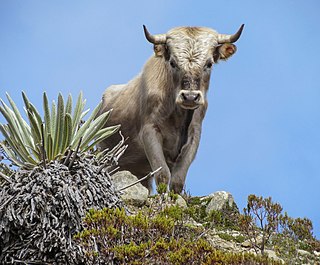
A maverick is an animal, usually a form of cattle, that does not carry a brand. It is a word also used to describe a person who acts free from constraints or organizational guidelines.

Photo-identification is a technique used to identify and track individuals of a wild animal study population over time. It relies on capturing photographs of distinctive characteristics such as skin or pelage patterns or scars from the animal. In cetaceans, the dorsal fin area and tail flukes are commonly used.
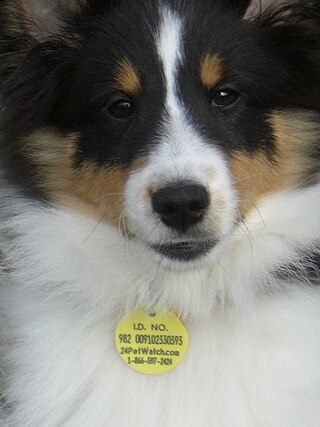
A pet recovery service is a service that has been created for the specific purpose of reuniting lost or stolen pets with their owners.
A human microchip implant is any electronic device implanted subcutaneously (subdermally) usually via an injection. Examples include an identifying integrated circuit RFID device encased in silicate glass which is implanted in the body of a human being. This type of subdermal implant usually contains a unique ID number that can be linked to information contained in an external database, such as identity document, criminal record, medical history, medications, address book, and other potential uses.

An animal tattoo or pet tattoo is a tattoo that a person has placed on an animal, which may be for animal identification, aesthetics, or artistic purposes. Animal identification via tattoo is a practice within the agricultural industry, at breeding farms, in scientific laboratories, and in the identification of domesticated pets. Anaesthetic or other methods of sedation are commonly administered for this type of procedure, with the aim to provide minimal harm and pain to the animal. There is a diversity of opinion concerning the morality of animal tattooing, related to concerns about animal welfare.
The history of wildlife tracking technology involves the evolution of technologies that have been used to monitor, track, and locate many different types of wildlife. Many individuals have an interest in tracking wildlife, including biologists, scientific researchers, and conservationists. Biotelemetry is "the instrumental technique for gaining and transmitting information from a living organism and its environment to a remote observer".

A coded wire tag (CWT) is an animal tagging device, most often used for identifying batches of fish. It consists of a length of magnetized stainless steel wire 0.25 mm in diameter and typically 1.1 mm long. The tag is marked with rows of numbers denoting specific batch or individual codes. The tag is usually injected into the snout or cheek of a fish so that it may be tracked for research or fisheries management.
































